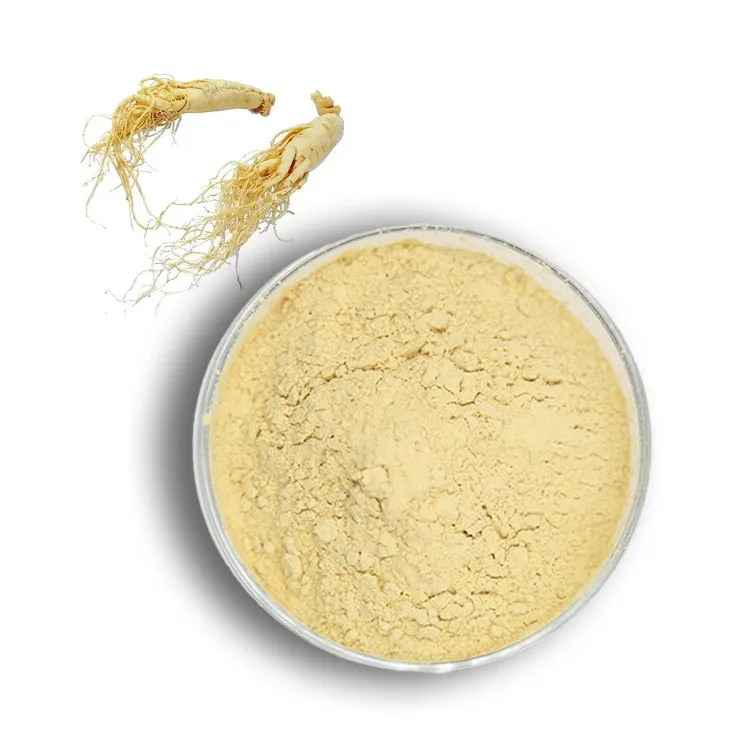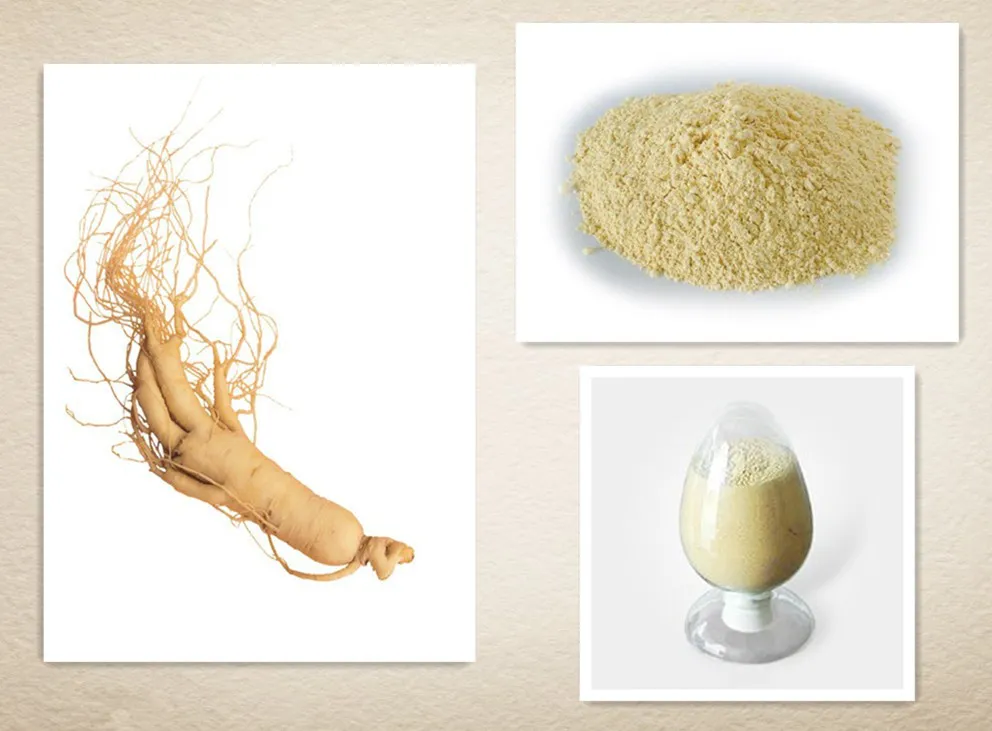- 0086-571-85302990
- sales@greenskybio.com
Extraction Technology and Production Process of Ginseng Root Extract.
2024-11-26

1. Introduction
Ginseng has been highly valued in traditional medicine for centuries due to its numerous health - promoting properties. Ginseng Root Extract, which contains a variety of bioactive compounds such as ginsenosides, polysaccharides, and flavonoids, is widely used in the pharmaceutical, food, and cosmetic industries. The extraction technology and production process play crucial roles in obtaining high - quality Ginseng Root Extract. This article aims to comprehensively discuss these aspects.

2. Extraction Technologies
2.1 Solvent Extraction
Solvent extraction is one of the most common methods for obtaining Ginseng Root Extract. It involves the use of solvents to dissolve the target compounds from the ginseng root matrix.
Solvent selection: Different solvents can be used depending on the nature of the compounds to be extracted. For example, ethanol is often preferred because it can effectively extract ginsenosides and other polar compounds. Hexane may be used for extracting non - polar components. However, the choice of solvent also needs to consider factors such as safety, cost, and environmental impact.
Procedure: The ginseng roots are first dried and ground into a fine powder. Then, the powder is mixed with the selected solvent in a suitable ratio. The mixture is typically stirred or shaken for a certain period, usually several hours to days, at a specific temperature. After that, the mixture is filtered to separate the extract from the solid residue. The solvent is then evaporated under reduced pressure to obtain the concentrated ginseng root extract.
2.2 Supercritical Fluid Extraction
Supercritical fluid extraction (SFE) has emerged as an advanced extraction technique for ginseng root extract. Supercritical fluids possess properties between those of gases and liquids, which make them excellent solvents for extraction.
The principle of SFE: Carbon dioxide (CO₂) is the most commonly used supercritical fluid in ginseng root extraction. At supercritical conditions (above its critical temperature and pressure), CO₂ has a high diffusivity and low viscosity, which allows it to penetrate the ginseng root matrix easily and dissolve the target compounds effectively. Moreover, by adjusting the pressure and temperature, the solubility of different compounds in CO₂ can be controlled, enabling selective extraction.
Advantages of SFE: One of the main advantages is that it is a "green" extraction method. Since CO₂ is non - toxic, non - flammable, and easily removed from the extract, there is no solvent residue in the final product. Additionally, SFE can produce extracts with high purity and better quality compared to solvent extraction in some cases.
Limitations and challenges: However, the equipment for SFE is relatively expensive, and the operation requires strict control of parameters such as pressure and temperature. Also, for some complex matrices like ginseng root, the extraction efficiency may not be as high as expected for certain compounds without proper optimization.
2.3 Microwave - Assisted Extraction
Microwave - assisted extraction (MAE) utilizes microwave energy to accelerate the extraction process of ginseng root extract.
Mechanism: Microwaves can directly interact with polar molecules in the ginseng root and the solvent, causing rapid heating. This internal heating mechanism leads to a more efficient transfer of target compounds from the matrix to the solvent. The heat generated by microwaves can also disrupt the cell walls of ginseng root cells, making the extraction easier.
Benefits: MAE is a relatively fast extraction method. It can significantly reduce the extraction time compared to traditional solvent extraction methods. For example, in some cases, the extraction time can be reduced from several hours to just a few minutes. This not only improves the extraction efficiency but also reduces the energy consumption.
Considerations: However, the microwave power and extraction time need to be carefully optimized. Excessive microwave power or too long extraction time may cause degradation of some heat - sensitive compounds in ginseng root, thus affecting the quality of the extract.

3. Production Process
3.1 Raw Material Selection
The quality of ginseng root extract is highly dependent on the quality of the raw materials. Ginseng variety plays a crucial role. Different varieties of ginseng, such as Panax ginseng, Panax quinquefolius, and Panax notoginseng, may have different compositions of bioactive compounds. For example, Panax ginseng is rich in certain ginsenosides that are highly valued in traditional medicine.
Growth environment also affects the quality of ginseng roots. Ginseng grown in suitable soil, climate, and altitude conditions usually has better quality. For instance, ginseng grown in cool, mountainous regions with well - drained soil is often considered of higher quality. The growth period of ginseng also matters. Longer - grown ginseng generally contains more bioactive compounds.
3.2 Pretreatment of Raw Materials
Before extraction, the ginseng roots need to be pretreated. Cleaning is the first step to remove dirt, soil, and other impurities from the roots. After cleaning, the roots are usually dried. There are different drying methods, such as air drying, oven drying, and freeze - drying. Freeze - drying is considered a good method as it can preserve the bioactive compounds in ginseng roots to a large extent. Once dried, the roots are ground into a powder with an appropriate particle size for extraction.
3.3 Extraction
Based on the selected extraction technology (as discussed in section 2), the extraction process is carried out. Whether it is solvent extraction, supercritical fluid extraction, or microwave - assisted extraction, the parameters need to be carefully optimized. These parameters include the solvent type and ratio (for solvent extraction), pressure and temperature (for supercritical fluid extraction), and microwave power and time (for microwave - assisted extraction).
3.4 Purification and Concentration
After extraction, the obtained extract may contain impurities and needs to be purified. Filtration is a common purification method to remove solid particles. Chromatographic techniques such as column chromatography can also be used to separate and purify specific bioactive compounds. For example, it can be used to separate different ginsenosides. After purification, the extract is usually concentrated to obtain a more concentrated product. Evaporation under reduced pressure is a common method for concentration.
3.5 Quality Control and Packaging
Quality control is essential throughout the production process of ginseng root extract. Analysis of bioactive compounds such as ginsenosides and polysaccharides is carried out using techniques like high - performance liquid chromatography (HPLC) and spectrophotometry. The extract needs to meet certain quality standards in terms of the content of bioactive compounds, purity, and safety.
Once the quality is verified, the ginseng root extract is packaged. Packaging materials should be chosen to protect the extract from light, moisture, and air to ensure its stability during storage and transportation.

4. Factors Influencing the Quality of the Extract
4.1 Ginseng Variety
As mentioned earlier, different ginseng varieties have different compositions of bioactive compounds. For example, some varieties may have a higher content of certain ginsenosides, which are the main active ingredients in ginseng root extract. The genetic characteristics of different varieties determine the biosynthesis and accumulation of these bioactive compounds in the roots.
4.2 Growth Environment
The growth environment of ginseng has a significant impact on the quality of the extract. Soil quality affects the uptake of nutrients by ginseng roots. For example, soil rich in organic matter and certain minerals can promote the growth and biosynthesis of bioactive compounds in ginseng. Climate conditions such as temperature, humidity, and sunlight also play important roles. Ginseng prefers cool and humid environments, and extreme weather conditions may affect its growth and the quality of the roots.
Altitude is another factor. Ginseng grown at different altitudes may have different qualities. Generally, ginseng grown at higher altitudes may have a slower growth rate but may contain more concentrated bioactive compounds due to the harsher environmental conditions.
4.3 Extraction Parameters
The extraction parameters have a direct impact on the quality of the ginseng root extract. In solvent extraction, the type and concentration of the solvent, extraction time, and temperature are important parameters. For example, using a higher concentration of ethanol may extract more ginsenosides, but it may also extract more impurities if the extraction time is too long. In supercritical fluid extraction, the pressure and temperature of the supercritical CO₂ need to be precisely controlled to ensure the optimal extraction of target compounds. In microwave - assisted extraction, the microwave power and extraction time need to be optimized to avoid the degradation of heat - sensitive compounds.

5. Conclusion
In conclusion, the extraction technology and production process of ginseng root extract are complex and multi - faceted. Different extraction technologies, including solvent extraction, supercritical fluid extraction, and microwave - assisted extraction, each have their own advantages and limitations. The production process, from raw material selection to the final product packaging, requires strict control to ensure the quality of the extract. Factors such as ginseng variety, growth environment, and extraction parameters all influence the quality of the ginseng root extract. Understanding these aspects is crucial for the development and production of high - quality ginseng root extract in the ginseng industry, herbal medicine, and natural product extraction fields.

FAQ:
What are the main extraction techniques for ginseng root extract?
There are several main extraction techniques for ginseng root extract. Solvent extraction is a common method, which uses solvents to dissolve and separate the active components from ginseng roots. Supercritical fluid extraction is another technique, where supercritical fluids, often carbon dioxide, are used as the extraction medium due to their unique properties. Microwave - assisted extraction is also applied, which utilizes microwave energy to enhance the extraction efficiency by accelerating the mass transfer process.
How does the ginseng variety affect the quality of the ginseng root extract?
Different ginseng varieties contain different levels and types of active components. For example, some varieties may have a higher concentration of ginsenosides, which are important bioactive compounds in ginseng. The genetic makeup of the variety determines its potential to produce these valuable substances. Also, different varieties may respond differently to the extraction process, which can ultimately influence the quality and composition of the extract.
What role does the growth environment play in the production of ginseng root extract?
The growth environment of ginseng has a significant impact on the quality of the root and thus the extract. Factors such as soil quality, climate, and altitude can affect the growth and development of ginseng roots. A suitable growth environment can promote the synthesis and accumulation of active components in ginseng roots. For instance, ginseng grown in nutrient - rich soil and a favorable climate may have a higher content of bioactive compounds, leading to a higher - quality extract.
What are the key extraction parameters in the production of ginseng root extract?
The key extraction parameters include factors such as temperature, pressure (in the case of supercritical fluid extraction), extraction time, and solvent - to - material ratio (in solvent extraction). For example, in solvent extraction, an appropriate solvent - to - material ratio ensures efficient extraction without wasting too much solvent. The extraction time needs to be optimized to obtain a sufficient amount of active components without causing degradation. Temperature and pressure can also significantly affect the extraction efficiency and the stability of the active components.
Can you briefly describe the production process of ginseng root extract from raw material selection?
First, in raw material selection, high - quality ginseng roots are chosen based on factors like variety, age, and quality. Then, the selected roots are usually cleaned to remove dirt and impurities. After that, depending on the extraction technique chosen (such as solvent extraction, supercritical fluid extraction, or microwave - assisted extraction), the appropriate extraction process is carried out. The resulting extract may then go through purification steps to remove unwanted substances. Finally, the purified extract is further processed and packaged as the final product.
Related literature
- Advances in Ginseng Root Extraction Technologies"
- "The Influence of Ginseng Growth Conditions on Extract Quality"
- "Optimization of Extraction Parameters for Ginseng Root Extract"
- ▶ Hesperidin
- ▶ citrus bioflavonoids
- ▶ plant extract
- ▶ lycopene
- ▶ Diosmin
- ▶ Grape seed extract
- ▶ Sea buckthorn Juice Powder
- ▶ Beetroot powder
- ▶ Hops Extract
- ▶ Artichoke Extract
- ▶ Reishi mushroom extract
- ▶ Astaxanthin
- ▶ Green Tea Extract
- ▶ Curcumin Extract
- ▶ Horse Chestnut Extract
- ▶ Other Problems
- ▶ Boswellia Serrata Extract
- ▶ Resveratrol Extract
- ▶ Marigold Extract
- ▶ Grape Leaf Extract
- ▶ blog3
- ▶ blog4
-
Chinese Withania somnifera Extract Factory.
2024-11-26
-
中国松树皮提取物粉粉末供应商
2024-11-26
-
High - quality Marigold Extract Products.
2024-11-26
-
100% Pure Natural Mango - Flavored Powder.
2024-11-26
-
Rose Hip Extract
2024-11-26
-
Almond Extract Powder
2024-11-26
-
Lycopene
2024-11-26
-
Yellow Pine Extract
2024-11-26
-
Beetroot Powder
2024-11-26
-
Curcumin Extract
2024-11-26
-
Baicalin
2024-11-26
-
Panax Ginseng Leaf Extract
2024-11-26
-
Dandelion Leaf Extract
2024-11-26
-
Senna Leaf Extract
2024-11-26





















